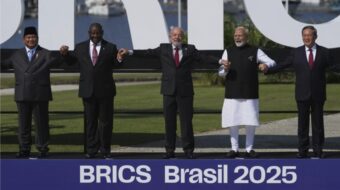Each year, the Institute for Policy Studies examines the list of the world’s billionaires and tries to put their wealth in perspective by comparing it to other things that are big and important in the world.
After 10 years of steady growth, the number of billionaires in the world declined in 2001 from 551 to 497, as billionaires the world over were hit by the same recessionary forces that plagued most of the world’s economies. According to new figures compiled by Forbes magazine, the 497 richest people on earth come from 43 countries, led by the United States with 216, Germany with 35 and Japan with 25.
Still, the 497 billionaires registered a healthy combined wealth of $1.54 trillion, well over the combined gross national products of all the nations of sub-Saharan Africa ($929.3 billion) or those of the oil-rich regions of the Middle East and North Africa ($1.34 trillion). Indeed, this collective wealth of the 497 is also greater than the combined incomes of the poorest half of humanity.
Leading the list yet again is Bill Gates, whose wealth dropped $6 billion over the past year, but remains at a healthy $52.8 billion, larger than Syria or Tunisia or any of the countries of Central America. Indeed, Gates’ wealth is greater than the entire unprecedented increase in defense spending requested by the Bush administration ($48 billion).
Number two on the list is the much-heralded investor, Warren Buffett, whose $35 billion surpasses the GDP’s of Croatia, Ecuador or Ghana. Software billionaires Paul Allen (Microsoft co-founder) and Lawrence Ellison (Oracle founder) each rack up around $25 billion; each is larger than Lithuania or the Ivory Coast. Either of these two could more than match the amount the U.S. gives in food stamps each year or triple the budget of the Environmental Protection Agency without a dent in their lifestyles.
This year, when Wal-Mart rose to become the largest firm in the world, founder Sam Walton’s widow and their four children show a collective wealth of over $100 billion, making them larger than either Hungary of oil-rich Nigeria.
Only 35 women – just 7 percent of the total – grace the billionaire list. But this is hardly surprising, since only 3.9 percent of America’s top-paid CEOs in the year 2000 were women.
Over the decades, U.S.-based billionaires have risen from a third of the total in the mid-1990s to almost half today. Indeed, so dominant are Americans at the top of the heap that 9 of the 11 individuals worth more than $20 billion are from the United States: only Prince Alwaleed Bin Talal Alsaud of Saudi Arabia and the Albrecht brothers of Germany join that elite list.
However, in terms of billionaires per capita, the United States is beaten out by Switzerland, Hong Kong and Singapore. Switzerland’s population of 7.2 million includes 13 billionaires, while 12 of Hong Kong’s 6.7 million people are in the club. Singapore comes in third, with 5 billionaires among 3.9 million people. Surprisingly, Sweden comes in fifth after the United States in the billionaires per capita category. Known for its egalitarianism, Sweden nevertheless has six billionaires among its population of 8.9 million.
The authors can be reached though the Institute for Policy Studies website at www.isp-dc.org.











